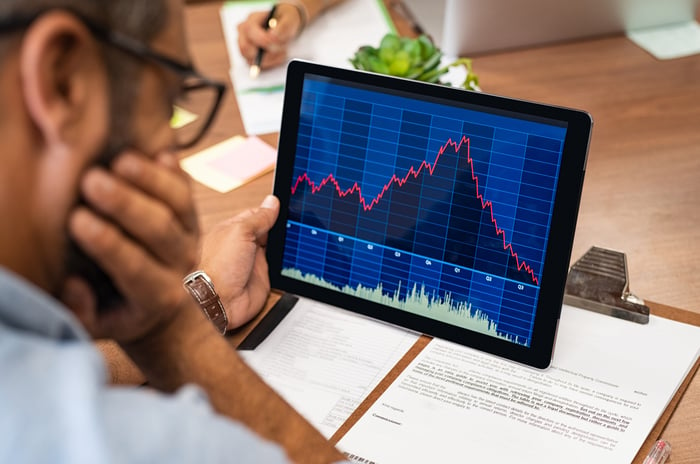Wall Street’s upcoming 10-for-1 stock split is being executed by a company whose business is, arguably, built on a house of cards.
While all eyes seem to be on the rise of artificial intelligence (AI), the hottest trend on Wall Street may well be companies doing stock splits.
A stock split is an event that allows publicly traded companies to change the price of their stock and the number of shares outstanding. Keep in mind that these adjustments are purely cosmetic and have no impact on a company’s market capitalization or underlying operating performance.

Image source: Getty Images.
There are two types of stock splits, although one is much more popular than the other. The first type is the early stock split, which aims to reduce the nominal price of a company’s stock in order to make it more affordable for retail investors. The other type of stock split is the reverse stock split. As the name suggests, a reverse stock split aims to increase the price of a company’s stock, often with the goal of ensuring that it remains listed on a major stock exchange.
Since the beginning of 2024, about a dozen prominent and/or well-known companies have announced stock splits. By far, most investors have turned to companies that are conducting early stock splits. Companies whose stock has risen to the point where a stock split is necessary are often more innovative and outperforming their peers.
Although companies that undertake stock splits have historically outperformed the benchmark index S&P 500 within 12 months of the initial announcement of a split, not all shares subject to a split are worth buying.
Wall Street’s newest member of this exclusive club is a perfect example of a company investors should avoid at all costs.
July Was a Busy Month for Fractional Stocks
Between stock split announcements and effective dates, July has been a busy month.
It started with one of Warren Buffett’s “forever” holdings at Berkshire Hathaway completing a discrete 2-for-1 stock split on July 1. Japan-based trading house Mitsui (NO 0.07%) (MITSF -4.00%) Mitsui is active in many key sectors and industries of the Japanese economy, including oil and gas, manufacturing and food production. Mitsui also has a highly shareholder-friendly operating structure, which now includes up to $1.3 billion in share repurchases (through September 20).
Next comes the furniture stocks Williams-Sonoma (WSM -2.22%) Williams-Sonoma completed a 2-for-1 stock split after the close of trading on July 8. Including dividend payments, Williams-Sonoma shares have soared more than 43,000% since its initial public offering (IPO) in 1983.
Although Williams-Sonoma’s stock is more expensive than it has been in recent years, the company has developed a competitive niche that targets middle- and upper-income consumers and relies on e-commerce to reduce its overhead.
Until July 11, the most recent stock split on Wall Street was that of an AI networking solutions specialist Broadcom (AVGO 0.27%)Broadcom’s 10-for-1 stock split went into effect after the close of trading on Friday, July 12, with the company opening at its split-adjusted price this morning (July 15).
Broadcom has responded to the growing demand for AI by providing networking solutions that reduce tail latency in high-computing data centers and maximize the computing capacity of AI graphics processing units.
Broadcom is also a leading supplier of chips and wireless accessories found in next-generation smartphones. Mobile companies upgrading their networks to support 5G speeds have spurred a device replacement cycle that has kept Broadcom’s order book high.
Although its forward earnings multiple is significantly higher than in previous years, Broadcom has the tools to meet the expectations of patient investors.

Image source: Getty Images.
Wall Street’s latest stock index could fall in coming years
While Mitsui, Williams-Sonoma, and Broadcom have the tools and intangibles to be good long-term investments, the same can’t be said for the newest member of the stock split club: AI-powered enterprise software analytics company. MicroStrategies (MSTR 16.87%).
On July 11, MicroStrategy’s board of directors approved a 10-for-1 stock split, which will take effect after the close of trading on August 7. Based on the July 11 closing price, the split will reduce MicroStrategy’s stock price to approximately $136, while increasing the number of shares outstanding by a factor of 10.
This move makes perfect sense and is something I’ve been waiting for. While MicroStrategy has had a software division for a decade, it’s best known for being the largest publicly traded stockholder Bitcoin (BTC 5.55%)Since late April, CEO Michael Saylor and his team have overseen the acquisition of an additional 11,931 bitcoins, bringing MicroStrategy’s total holdings to 226,331 tokens. Keep in mind that only 21 million bitcoins will be mined.
With retail investors and social media hype being the primary drivers of the cryptocurrency boom, it made perfect sense for MicroStrategy’s board to make its stock more affordable to everyday investors who might not have access to fractional stock purchases through their broker. In fact, the company’s board specifically noted that the split was intended to “make MicroStrategy’s stock more accessible to investors and employees.”
The problem for MicroStrategy is that most of its $24 billion market capitalization is not backed by anything tangible.
While Bitcoin once had the advantage of being the first to move in the cryptocurrency space, it has been left behind by many next-generation blockchain projects. Bitcoin is far from the fastest or cheapest when it comes to validating and settling transactions.
To top it all off, Salvador’s experiment with Bitcoin as legal tender has been a failure. According to a survey conducted by the Central American University’s Institute of Public Opinion, 88% of Salvadorans have not used Bitcoin in 2023, despite the government’s efforts to adopt it. Reality has shown that Bitcoin offers little utility and scarcity in the real world.
Additionally, MicroStrategy’s Bitcoin assets are valued at a significant premium to the current price of Bitcoin. The 226,331 tokens currently held by MicroStrategy are worth approximately $12.98 billion, as of this writing ($57,347/Bitcoin). However, MicroStrategy’s $24 billion market cap, assuming a reasonable $1-2 billion valuation for software operations, implies a valuation of $22-23 billion for Bitcoin assets. In other words, investors are paying between $97,200 and $101,600 per Bitcoin when buying MicroStrategy stock when they could simply buy Bitcoin on a cryptocurrency exchange for $57,347 per token.
As a cherry on top, MicroStrategy funded its leveraged Bitcoin strategy by issuing convertible bonds. If Bitcoin were to crash, as it has many times over the past decade, MicroStrategy could be forced to drown its investors in new equity to cover its debt obligations.
With its declining software business (annual sales have fallen 14% over the past 10 years) and its valuation built on a house of cards, MicroStrategy is a stock to avoid like the plague.